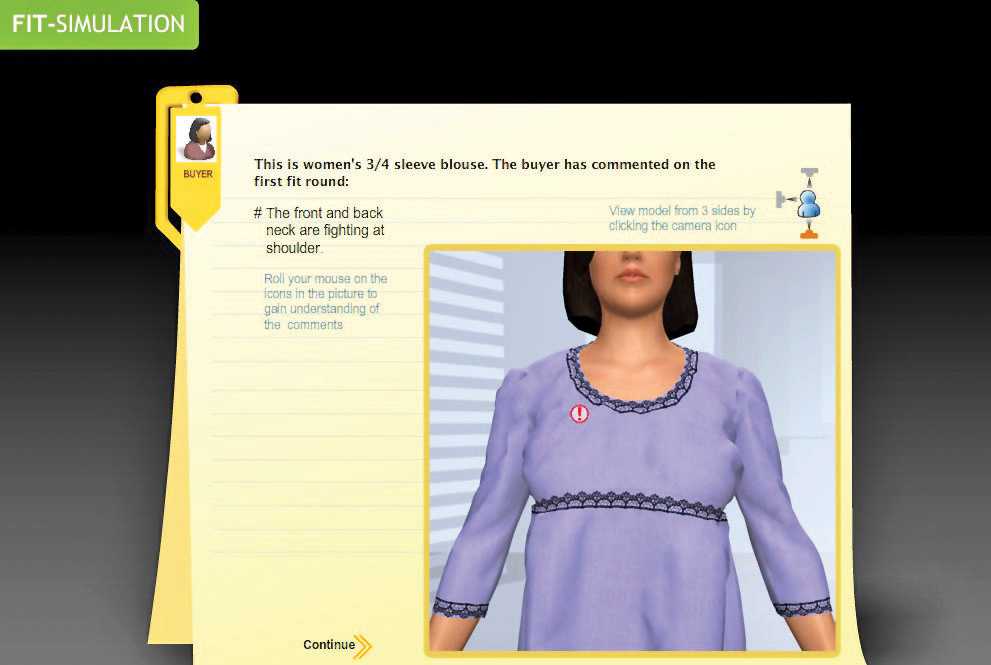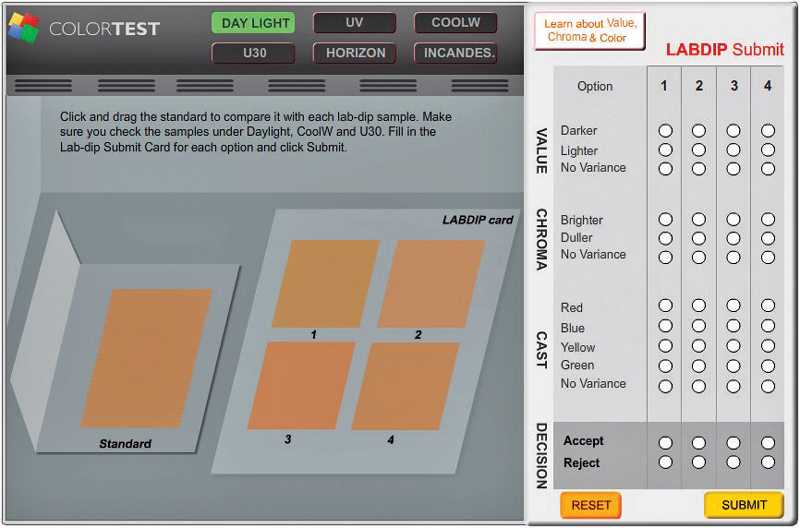
The new style looked very interesting, but it raised too many questions in the merchant’s mind. How will she manage colour variation when the garments are overdyed? What will happen to the antique-finish buttons? Will they stain the garment? What about the weight of the fabric – will that be a problem? It was late, but she wanted to get some answers before going into work the next day.
She logged in and searched for garment dyeing. Bingo! There were a bunch of case studies, some simulations and a lot of other information. As she read through, she discovered what had been tried before, what had worked and what didn’t. She smiled to herself – she was going to get some sleep after all.
Sounds like an impossible situation…! For more than a year now, Associates at Triburg have been using exactly this kind of state-of-the-art eLearning platform.
When most people think of eLearning, they think of pages of content much like what you might find in web searches. At best, they imagine nicely formatted pages with pretty graphics and cool animation. However, real eLearning engages the minds of users and makes them think. And that’s where it all started at Triburg.
Over the last 30 years, Triburg, India’s leading apparel sourcing company, has built a brand that has three key features: 360-degree thinking, deep engagement with the product, and continuous learning. Given the diversity of products that the company deals with, learning accumulates very quickly on a daily basis. In the early days of the company, living the essence of the brand was easy because you could just get people together for intensive sharing and training sessions.
As Triburg teams grew larger and more specialized, and as they became more geographically dispersed, the strategy of getting people together became increasingly difficult. Also, with business pressures increasing, time management became more and more challenging, especially with Triburg’s policy of lights-out at 5:30 PM. Soon, the company realized that the solution lay in using a technology-based approach to knowledge management.
As you read about how Triburg solved this problem, keep in mind that knowledge is neither data nor information. Knowledge is not contained in documents, but resides in people’s heads. It’s compressed experience. So when we talk about managing knowledge, we are talking about making the collective experience of the organization available to people in a way that causes action.
The most pressing knowledge management need at Triburg is to share learning from past mistakes. Although teams typically are specialized by product type, many issues are common across teams. Also, problems solved by one team are repeated by others because they do not know about solutions that exist in other teams, sometimes in other cities.
The Case Studies section of the learning website has a large collection of past issues and their resolution. The cases are classified in terms of fabric, trims and embellishments, product development, product testing, technical evaluation, manufacturing, and wet & dry processes. Each case describes the problem or issue, provides perspectives from multiple roles (e.g. merchant, QA, customer, etc.) and describes the solution. Each case ends with key learning that users can remember and apply to their own situations.
Our usage analysis of the site shows that Case Studies are used consistently by Associates. Many users have reported how, when faced with a problem, a visit to the site and a quick search saved them precious time and money. The challenge, however, is to continuously add to the collection of Case Studies.

One of the most popular parts of the site is Simulations. These are interactive exercises that place Associates in realistic business situations. Users have to navigate through the situation using their knowledge of merchandising and product management. Associates are presented with a series of cumulative decisions – correct decisions take them to mission success, while wrong decisions lead to failure. Three scores are tracked in each Simulation: Cost of Quality, Resolution Time and Network Quotient. Network Quotient measures the degree to which a user reaches out to experts in the system while trying to solve their business problem. This is one of the most important lessons that Triburg instills in each Associate – don’t fly solo, but use the expertise that exists in the company.
Simulations have turned out to be the most powerful training tool on the site. They train the user to think logically and holistically about problems and how to approach them. Simulations mimic the real world of decisions, but allow Associates to make mistakes and learn from them. A 15-day decision making process might be compressed into a 30-minute Simulation, leading to an intense learning experience. Interestingly, Simulations are often used in groups of three to five Associates. At each decision point, the group debates the pros and cons of each decision and learns from that group interaction as well.
An unplanned spin-off of the Simulations is their use as a hiring tool. Because they test an Associate’s thinking skills, they have turned out to be a powerful tool in candidate selection. Also, every action and mouse-click of the user is recorded, so we can analyze the thought process of the user. We are able to report how many times a person attempted each simulation, how long they took, were they successful, their sequence of decision making and their scores on each attempt. It’s almost as if you can look into the mind of the candidate!
There are several other kinds of interactive learning modules on the site. Some deal with colour and train the eye of the merchant through a simulated light box. Users can test their colour discrimination and be aware of their strengths and weaknesses when it comes to colour approvals. The online colour discrimination test also records scores, and displays names of Associates with the best colour discrimination ability.
Other modules deal with fits and patterns, where the user can change patterns and see the result on a 3-D model. The idea is not to make merchants pattern experts but to create a vocabulary that can be used in productive discussions with the customer and the technical team. Interpreting and closing fit comments quickly can have a significant impact on timelines and customer satisfaction.
With the changing dynamics of the industry, design and product development are becoming increasingly important. During product development, several factors have to be balanced to deliver a design option: cost, production feasibility, production time and aesthetics. The product development module on the site includes several interactive exercises in which the user is given a style and has to come up design options. As the user makes changes to the style, the cumulative impact of the changes is shown on each of the factors on a dashboard. This module trains the Associates to think in terms of multiple dimensions of the product.
When we analyzed the tasks and work patterns of Associates, we found that a significant amount of each day is spent reading and responding to emails from customers, vendors, mills and other suppliers. We also found that many problems arose or persisted because of ineffective email skills. For example, writing “appreciate your patience” has a very different effect on a customer than writing “please be patient”.
So we created an online coaching tool called Email Coach. In this tool, Associates are presented with a range of situations. Based on a situation, the Associate has to compose an email. This email is then sent to a team of Coaches in the company who provide detailed feedback on the quality of the email. Associates can see their own emails and feedback as well as all other Associates’ emails. Names of Associates and Coaches are not included to ensure that people do not feel insecure about posting their emails and receiving feedback.
For new hires at Triburg, one of the most important places to visit on the site is the Process Overview Section. This section describes the Triburg SOPs through an interactive process map. The user can drill down to the lowest level of each process. Each step of a process is described in detail. Document and formats relevant to a step are available for download and review.
Apart from interactive modules, the site includes a comprehensive database of information related to textiles and apparel. The database contains descriptions of key concepts, such as different kinds of weaves. There are videos of important manufacturing and finishing processes, as well as a glossary of terms. So, if a customer is interested in sublimation printing, all that the Associate has to do is visit the site to know what that means.
As we collected data on site usage, we found that many Associates visit the site to take a quick break from their high-pressure jobs. This led to the design of a Daily Essentials section that is pure fun. Each day has a theme: on Mondays it’s a horoscope, Tuesday has brand quiz, each Wednesday has a new comic strip, there’s a poll on Thursdays, and the last day of the week has a fun quote. To rephrase an old saying – all work and no play makes Jack a dull Associate. Sometimes, all it takes to get through a tough day at work is a bit of humour.
When you put it all together, Triburg has created a comprehensive knowledge management platform that addresses the complex learning needs of a dynamic, ever-changing industry. Developed entirely in-house, the platform is flexible, scalable, secure and robust.
As the site evolves, some parts of it will take on the shape of a performance support system (PSS), which means a tool that can be used to support an Associate’s current tasks. An example of a PSS is the set of conversion tools we have built into the site for converting fabric weight, length, currency, time zones, etc. Other parts of the site will remain focused on the core learning issues of conceptual understanding, case-based reasoning and analytical and decision-making skills.
Like any other internal eLearning site, the greatest challenge before us is utilization. After the initial novelty wears off, getting people to keep visiting the site is the key issue. Time is the scarcest resource in this industry and it’s tempting to stay focused on daily transactions. Few Associates have the maturity to understand that a few hours spent on research and learning at the beginning of the product life cycle can save several days and dollars later in the process.
For people to invest time in learning, and to take the time to anticipate problems, there needs to be a cultural change in the industry. Traditionally, people have been rewarded for their fire-fighting ability. Very rarely do we investigate why the fire started in the first place and what we can do to make sure it never happens again. Short-term productivity has been more important than long-term success. At Triburg, we are trying to reverse this tide.
Knowledge management is a business issue for Triburg. As a global player, the company needs to create, share and reapply knowledge on a global scale. This can only happen through smart use of information technology and the sustained engagement of every Associate as an active contributor. Much needs to be learned and implemented to make this work for the long term. It’s going to be an exciting journey!

Leave a Reply